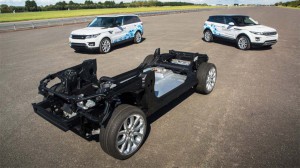Like the rest of the auto industry, Jaguar Land Rover is struggling to cope with an assortment of ever-tougher fuel economy and emissions standards, including the 54.5 mpg CAFE rules that will go into place in the U.S. in 2025. That’s especially challenging when your line-up emphasizes large and high-performance products such as the Jaguar F-Type and Range Rover.
The British maker has taken a few steps to meet those mandates, adding a couple hybrids and a range of diesels and new V-6s, but it also knows that it will have to take further steps, including more lightweighting – and the addition of new, more advanced, battery-based powertrain systems.
JLR offered a hint of what could come this week with the unveiling of three electrified concepts at a conference in Millbrook, England. Dubbed Concept_e, these “research demonstrators” went from what you might call mild to heavy use of battery power.
Significantly, these are not the sort of hybrids and battery-electric vehicles that are designed solely for low emissions and high mileage. The emphasis is to create environmentally friendly performance and luxury vehicles.
(Jaguar shows off its first crossover, the F Pace, ahead of Frankfurt debut. Click Here for more.)
The full battery-electric version, for example, uses an 85 kilowatt, or 115 horsepower, motor paired with a single-speed transaxle up front, and a 145 kW, or 194 hp, motor using a two-speed gearbox to drive the rear axle. While the combined horsepower rating is modest compared to some JLR products, one needs to remember that electric motors develop far more torque than horsepower – and that comes on almost instantaneously.
The twin-motor system draws power from a 70-kilowatt-hour lithium-ion battery built into the vehicle’s underbody to lower its center of gravity. That would potentially deliver well over 200 miles of range, in line with a Tesla Model S P70.
While the battery-electric Concept_e is a pure research model, JLR offered a bit more of a real-world sense of what’s coming with a plug-in hybrid version of the Range Rover Sport. It pairs a gas engine and eight-speed automatic drive with a 150-kilowatt electric motor.
The gas engine turns out 300 metric horsepower, or 296 hp in American numbers, so this could be a true tire-spinner also capable of driving in urban environments solely in electric mode. The 320-volt lithium-ion battery mounts in the prototype’s cargo bay.
The third Concept_e prototype is a mild, or more conventional hybrid based on the Range Rover Evoque. While it would likely have little to no electric-only range, the 15-kW electric motor and compact lithium-ion battery should help deliver significantly better mileage, especially when paired with an 89 hp diesel.
(Click Here for a review of the new Range Rover Sport Td6 diesel.)
It’s anybody’s guess how broad a market there will be for pure battery-electric luxury vehicles, though Tesla seems to be finding a reasonable niche. Larger luxury makers, like Mercedes-Benz and BMW, will almost certainly have to add them to their fleets to meet the new California ZEV requirements. Lower-volume brands, including Jaguar, will be allowed to get by with plug-ins. And, as several senior JLR officials told TheDetroitBureau.com last week, that’s the approach they are focusing on most aggressively.
Exactly how soon we’ll see production versions of any of these Concept_e prototypes is uncertain, but insiders hint a JLR plug-in is only a few years away.
For his part, R&D boss Wolfgang Epple said the maker is “exploring all aspects of future hybrid and battery-electric vehicle technology,” adding that what comes out the Concept_e project “could form part of our low- and zero-emissions vision beyond 2020.”
(Gas-powered cars could soon become the exception, rather than the rule, in Calif. Click Here for the full story.)

